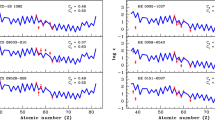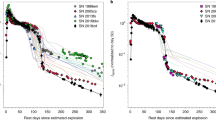Abstract
CEMP-r/s stars at low metallicity are known as double-enhanced stars that show enhancements of both r-process and s-process elements. The chemical abundances of these very metal-poor stars provide us a lot of information for putting new restraints on models of neutron-capture processes. In this article, we put forward an accreted scenario in which the double enrichment of r-process and s-process elements is caused by a former intermediate-mass Asymptotic Giant Branch (AGB) companion in a detached binary system. As the AGB superwind is only present at the ultimate phase of AGB stars, there is thus a lot of potential that the degenerate-core mass of an intermediate-mass AGB star reaches the Chandrasekhar limit before the AGB superwind. In these circumstances, both s-process elements produced in the AGB shell and r-process elements synthesized in the subsequent explosion would be sprayed contemporaneously and accreted by its companion. Despite similarity to physical conditions of a core-collapse supernova, a major focus in this scenario is the degenerate C–O core surrounded by an envelope of a former intermediate-mass AGB donor that may collapse and explode. Due to the existence of an outer envelope, r-process nucleosynthesis is expected to occur. Hypothesizing the material-rich europium (Eu) accreted by the secondary via the wind from the supernova to be in proportion to the geometric fraction of the companion with respect to the exploding donor star, we find that the estimated yield of Eu (as representative of r-process elements) per AGB supernova event is about 1 × 10−9 M ⊙ ∼ 5 × 10−9 M ⊙. Using the yields of Eu, the overabundance of r-process elements in CEMP-r/s stars can be accounted for. The calculated results show that the value of parameter f , standing for efficiency of wind pollution from the AGB supernova, will reach about 104, which means that the enhanced factor is much larger than unity due to the impact of gravity of the donor and the result of the gravitational focusing effect of the companion.





Similar content being viewed by others
References
Aoki, W., Ryan, S. G., Norris, J. E., Beers, T. C., Ando, H., Tsangarides, S. 2002, Apj, 580, 1149.
Aoki, W. et al. 2003, ApJ, 592, L67.
Aoki, W., Bisterzo, S., Gallino, R., Beers, T. C., Norris, J. E., Ryan, S. G., Tsangarides, S. 2006, ApJ, 650, L127.
Arcones, A., Montes, F. 2011, ApJ, 731, 5.
Arnould, M., Goriely, S., Takahashi, K. 2007, Phys. Rep., 450, 97.
Banerjee, P., Haxton, W. C., Qian, Y.-Z. 2011, Phys. Rev. Lett., 106, 1104.
Barklem, P. S. et al. 2005, A&A, 439, 129.
Barbuy, B., Jorissen, A., Rossi, S. C. F. et al. 1992, A&A, 262, 216.
Barbuy, B., Spite, M., Spite, F., Hill, V., Cayrel, R., Plez, B., Petitjean, P. 2005, A&A, 429, 1031.
Beers, T. C., Christlieb, N. 2005, ARA&A, 43, 531.
Bisterzo, S., Gallino, R., Straniero, O., Aoki, W. 2009, PASA, 26, 314.
Bisterzo, S., Gallino, R., Straniero, O., Cristallo, S., Käppeler, F., 2010, MNRAS, 404, 1529.
Bisterzo, S., Gallino, R., Straniero, O. et al. 2012, MNRAS, 10.1111/j.1365-2966.2012.20670.x.
Boffin, H. M. J., Jorissen, A. 1988, A&A, 205, 155.
Burbidge, E. M., Burbidge, G. R., Fowler, W. A., Hoyle, F. 1957, Rev. Mod. Phys., 29, 547.
Busso, M., Gallino, R., Wasserburg, G. J. 1999, ARA&A, 37, 239.
Campbell, S. W., Lattanzio, J. C. 2008, A&A, 490, 769.
Cohen, J. G., Christlieb, N., Qian, Y.-Z., Wasserburg, G. J. 2003, ApJ, 588, 1082.
Cohen, J. G. et al. 2005, ApJ, 633, L109.
Cristallo, S. et al. 2011, ApJS, 197, 17.
Delaude, D., Gallino, R., Critallo, S., Straniero, O., Husti, L., Ryan, S. 2004, Mem. Soc. Astron. Italiana, 75, 706.
Dillmann, I., Litvinov, Y. A. 2011, Prog. Part. Nucl. Phys., 66, 358.
Doherty, C. L., Siess, L., Lattanzio, J. C., Gil-Pons, P. 2010, MNRAS, 401, 1453.
Farouqi, K., Freiburghaus, C., Kratz, K.-L., Pfeiffer, B., Rauscher, T., Thielemann, F.-K. 2005, Nuc. Phys. A, 758, 631.
Farouqi, K., Kratz, K.-L., Mashonkina, L. I., Pfeiffer, B., Cowan, J. J., Thielemann, F.-K., Truran, J. W. 2009, ApJ, 694, L49.
Freiburghaus, C., Rosswog, S., Thielemann, F.-K. 1999, ApJ, 525, L121.
Gallino, R., Arlandini, A., Busso, M., Lugaro, M., Travaglio, C., Straniero, O., Chieffi, A., Limongi, M. 1998, ApJ, 497, 388.
Gallino, R., Delaude, D., Husti, L., Cristallo, S., Straniero, O., Ryan, S. 2005, Nucl. Phys. A, 758, 485c.
Gil-Pons, P., Gutiérrez, J., García-Berro, E. 2007, A&A, 464, 667.
Goriely, S., Mowlavi, N. 2000, A&A, 362, 599.
Goriely, S., Siess, L. 2004 A&A, 421, L25.
Goriely, S., Siess, L. 2005. in From Lithium to Uranium: Elemental Tracers of Early Cosmic Evolution, edited by V. Hill, P. François & F. Primas, IAU Symposium, 451, 60.
Han, Z., Podsiadlowski, Ph. 2004, MNRAS, 350, 1301.
Herwig, F. 2005 AR&A , 43, 435.
Hill, V. et al. 2000, A&A, 353, 557.
Hoyle, F., Lyttleton, R A. 1939, Proc. Cambridge Phil. Soc., 35, 405.
Hurley, J. R., Tout, C. A., Pols, O. R. 2002, MNRAS, 329, 897.
Iliadis, C., Angulo, C., Descouvemont, P., Lugaro, M., Mohr, P. 2008, Phys. Rev. C, 77 045802.
Ivans, I. I., Sneden, C., Gallino, R., Cowan, J. J., Preston, G W. 2005, ApJ, 627, L145.
Ishimaru, Y., Wanajo, S., Aoki, W., Ryan, S G. 2004, ApJ, 600, L47.
Izzard, R. G., Glebbeek, E., Stancliffe, R. J., Pols, O R. 2009, A&A, 508, 1359.
Johnson, J. A., Bolte, M. 2004, ApJ, 605, 462.
Johnson, J. A., Herwig, F., Beers, T. C., Christlieb, N. 2007, ApJ, 658, 1203.
Jonsell, K., Barklem, P. S., Gustafsson, B., Christlieb, N., Hill, V., Beers, T. C., Holmberg, J. 2006, A&A, 451, 651.
Jorissen, A., Van Eck, S., Mayor, M., Udry, S. 1998, A&A, 332, 877.
Käppeler, F., Gallino, R., Bisterzo, S., Aoki, W. 2011, Rev. Mod. Phys., 8, 157.
Karakas, A. I., Lugaro, M. A., Wiescher, M., Göres, J., Ugalde, C. 2006, ApJ, 643, 471.
Karakas, A., Lattanzio, J C. 2007, PASA, 24, 103.
Komiya, Y., Suda, T., Minaguchi, H., Shigeyama, T., Aoki, W., Fujimoto, M Y. 2007, ApJ, 658, 367.
Lagadec, E., Zijlstra, A. A., Mauron, N. et al. 2010, MNRAS, 403, 1331.
Lau, H. H. B., Stancliffe, R. J., Tout, C. A. 2007, MNRAS, 378, 563.
Lau, H. H. B., Stancliffe, R. J., Tout, C. A. 2008, MNRAS, 385, 301.
Lau, H. H. B., Stancliffe, R. J., Tout, C. A. 2009, MNRAS, 396, 1046.
Lucatello, S., Tsangarides, S., Beers, T. C., Carretta, E., Gratton, R. G., Ryan, S. G. 2005, ApJ, 625, 825.
Lucatello, S., Beers, T. C., Christlieb, N., Barklem, P. S., Rossi, S., Marsteller, B., Sivarani, T., Lee, Y. S. 2006, ApJ, 652, L37.
Lucatello, S., Masseron, T., Johnson, J. A. 2009, PASA, 26, 303.
Lugaro, M., Campbell, S. W., de Mink, S. E. 2009, PASA, 26, 322.
Lugaro, M., Karakas, A. I., Stancliffe, R. J., Rijs, C. 2012, ApJ, 747, 2.
Marshall, J. R., van Loon, J. T., Matsuura, M., Wood, P. R., Zijlstra, A. A., Whitelock, P. A. 2004, MNRAS, 355, 1348.
Masseron, T., Johnson, J. A., Plez, B., Van Eck, S., Primas, F., Goriely, S., Jorissen, A. 2010, A&A, 509, A93.
McClure, R. D., Woodsworth, A. W. 1990, ApJ, 352, 709.
Nomoto, K., Wanajo, S., Iwamoto, N., Ishimaru, Y. 2004, in Proc. 12th Workshop on Nuclear Astrophysics, edited by E. Muller & H.-T. Janka (Garching: MPA), 123.
Pols, O. R., Izzard, R. G., Glebbeek, E., Stancleffe, R. J. 2009, PASA, 26, 327.
Proffitt, C. R., Michaud, G. 1989, ApJ, 345, 998.
Qian, Y.-Z., Wasserburg, G. J. 2003, ApJ, 588, 1099
Qian, Y.-Z., Wasserburg, G. J. 2007, Phys. Rep., 442, 237.
Roederer, I. U., Marino, A. F., Sneden, C. 2011, ApJ, 742, 37.
Rosswog, S., Davies, M. B., Thielemann, F.-K., Piran, T. 2000, A&A, 360, 171.
Siess, L. 2007, A&A, 476, 893.
Sneden, C., Cowan, J. J., Gallino, R. 2008, ARA&A, 46, 241.
Stancliffe, R. J., Glebbeek, E. 2008, MNRAS, 389, 1828.
Stancliffe, R. J. 2009, MNRAS, 394, 1051.
Straniero, O., Gallino, R., Busso, M. et al. 1995, ApJ, 440, L85.
Suda, T., Katsuta, Y., Yamada, S. et al. 2008, PASJ, 60, 1159.
Suda, T., Fujimoto, M. Y. 2010, MNRAS, 405, 177.
Sumiyoshi, K., Terasawa, M., Mathews, G. J., Kajino, T., Yamada, S., Suzuki, H. 2001, ApJ, 562, 880.
Thompson, I. B. et al. 2008, ApJ, 667, 556.
Tur, C., Heger, A., Austin, S. M. 2009, ApJ, 702, 1068.
van Loon, J. Th., Groenewegen, M. A. T., de Koter, A. et al. 1999, A&A, 351, 559.
van Loon, J. Th., Marshall, J. R., Matsuura, M., Zijlstra, A. A. 2003, MNRAS, 341, 1205.
Wanajo, S., Kajino, T., Mathews, G. J., Otsuki, K. 2001, ApJ, 554, 578.
Wanajo, S., Tamamura, M., Itoh, N., Nomoto, K., Ishimaru, I., Beers, T. C., Nozawa, S. 2003, ApJ, 593, 968.
Wanajo, S., Nomoto, K., Iwamoto, N., Ishimaru, Y., Beers, T. C. 2006, ApJ, 636, 842.
Wang, B., Han, Z. 2012, ArXiv e-prints, 1204.1155.
Weiss, A., Ferguson, J. W. 2009, A&A, 508, 1343.
Woosley, S. E., Hoffman, R. D. 1992, ApJ, 395, 202.
Woosley, S. E., Wilson, J. R., Mathews, G. J., Hoffman, R. D., Meyer, B. S. 1994, ApJ, 433, 229.
Zhang, B., Ma, K., Zhou, G. D. 2006, ApJ, 642, 1075.
Zijlstra, A. A. 2004, MNRAS, 348, L23.
Acknowledgements
This work is supported by the National Natural Science Foundation of China (Grant Nos, 11273011, 10973006, 10821061, 11033008, 11103072, 10973036 and 11003002); the National Basic Research Program of China (Grant No. 2009CB824800); the Chinese Academy of Sciences (Grant No. KJCX2-YW-T24); Open Research Program of Key Laboratory for the Structure and Evolution of Celestial Objects, Chinese Academy of Sciences, and the Natural Science Foundation of Hebei Province under Grant No. A2012403006 and No. A2011210017.
Author information
Authors and Affiliations
Corresponding author
Rights and permissions
About this article
Cite this article
Zhang, J., Zhao, F., Chen, Y. et al. Puzzling Origin of CEMP-r/s Stars: An Interpretation of Abundance and Enrichment of s- and r-Process Elements from Asymptotic Giant Branch Supernovae. J Astrophys Astron 34, 373–391 (2013). https://doi.org/10.1007/s12036-013-9191-7
Received:
Accepted:
Published:
Issue Date:
DOI: https://doi.org/10.1007/s12036-013-9191-7




